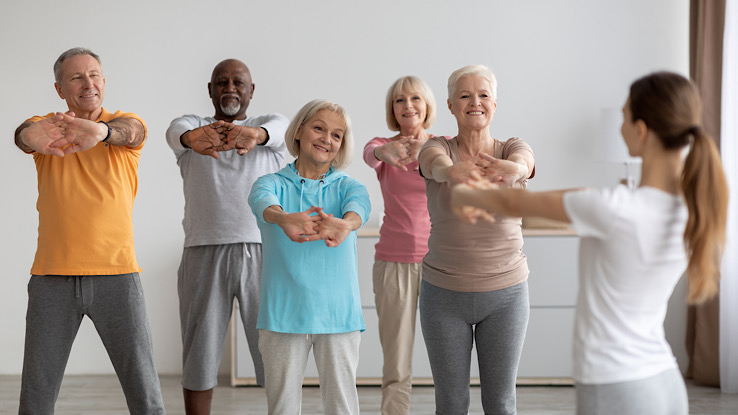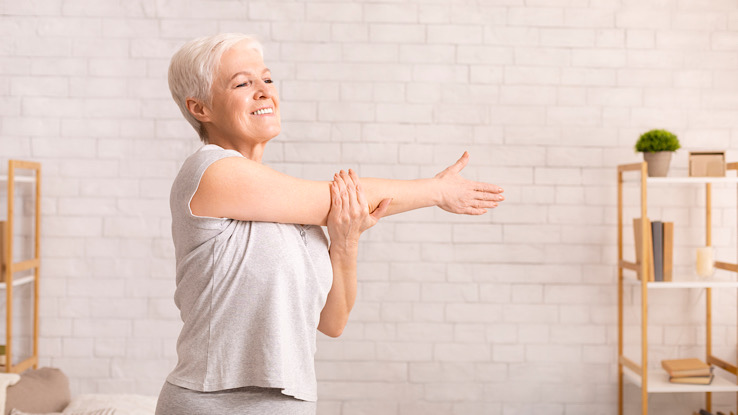
Naturally, most people are eager to stay active and mobile as they get older. Recreational activities often provide important social and physical support for us as we age. The key is staying flexible and fit enough to participate safely. Fortunately, simple stretches for older adults will help you manage and improve your physical fitness. Still not convinced?
Research shows the benefits of gentle exercise for older adults aged 60 and over. Many doctors, like arthritis specialists, believe routine stretching and other gentle exercises can:
- Reduce inflammation
- Improve joint pain
- Maintain muscle tone
- Improve range of motion (ROM)
Additionally, exercise improves mental health, and injuries decrease with regular stretching. Flexibility exercises prevent muscles from shortening, which can cause muscle damage, strains, and even joint pain.
5 Things to Consider Before Starting Your Simple Stretches for Older Adults
Maybe you already believe that movement is medicine. You want to stay active and adopt a stretching routine. But how do you get started?
For any new gentle stretching exercises to work for you, there must be a routine that fits your lifestyle and schedule. Here are a few things to consider including:
- Time of Day: Try to identify when you have 15-30-minutes to complete the exercise and make it the same 15-30-minutes each day. Also to consider – are you a morning person? If you generally have morning stiffness, you may want to plan your sessions for the afternoon.
- Safety: Start slow. If you are just starting to become more active, don’t push yourself too hard at first and risk injury. If you are unsteady, you will want to schedule your stretches when someone is with you. Perhaps a friend, spouse, child, or caregiver can act as a spotter, so you don’t fall.
- Doctor’s Input: As always, it is important to check with your doctor before starting any exercise or stretching routine. With current telehealth options, this can be easy to accomplish.
- Athletics: If you are an athlete (i.e., pickleball, jogging, golf), plan your stretching sessions for after the workout. You will get the maximum benefit from stretching those warm muscles and joints.
- Sustainability: The gentle stretching routine will work best if you go into it with the commitment to continue. So what tools or habits will help you keep it up? Try setting yourself small short-term goals that give you a sense of achievement along the way and build your way up to achieving your longer-term goals. Maybe you need the accountability of a stretching partner. Or perhaps an exercise tracking app.
Simple Stretches for Older Adults: 5-Head to Toe Stretches

Stretches are the most recommended flexibility exercise for older adults. Stretching involves activating your connective tissues – like ligaments and fascia – that link your body’s muscles, bones, blood vessels, and organs.
Stretches should not be painful or overly difficult to complete. Stretches should be gentle tension on the targeted muscles and joints. If you are looking for advanced stretches and a few modifications, check out some options below.
Before you begin, make sure you have a sturdy chair available. It should have four legs on the ground, without wheels or rocking motion. Links to instructional videos can are on the National Institute of Aging website. Once you practice them a few times, it will become second nature. You can do each gentle stretching exercise in 3-5 minutes. Of course, you can linger in any position if that feels good to you.
Neck stretches
Neck stretched can loosen up your neck and help you focus on your stretching session.
- Sit upright on a sturdy chair. Feet flat on the ground. Hands resting on your thighs.
- Imagine drawing a clockwise circle with your nose
- This is not a big motion. Increase the size of the circle when you are able.
- Breath naturally
- Complete 5-circles clockwise
- Complete 5-circles counterclockwise
Seated Shoulder/Upper Back Stretch
Shoulders and torso joints are some of the first to lose their range of motion. Try this simple stretch for older adults:
- Extend left arm and hold straight
- Hook the right forearm up and under the left arm
- Gently use your right arm to pull your left arm across your torso
- Do not shrug; instead, drop your shoulders away from your ears
- Breath naturally
- Hold for 10-seconds
- Release and repeat on the right side
- Complete 3-5 sets
Seated Back/Torso Stretch
Stretching the back muscles can relieve stress and improve posture. Try this simple stretch for older adults:
- Find a sturdy chair with arms
- Hold the left armrest with the left hand
- Place right hand on the outside of the left thigh
- Turn to look over your left shoulder and hold
- Breath naturally
- Hold for 10-seconds
- Release and face forward
- Repeat 3 – 5 times on the left side
- Repeat sequence on right side
Advanced Option: hold the chair farther up on the armrest or even the chair back for a deeper stretch. Do not crane your neck.
Seated Ankle Stretch
Seated ankle stretch can help improve flexibility and stimulate your joints. Try this simple stretch for older adults:
- Sit upright in a sturdy chair
- Move your body to the front half of the chair
- Hold the chair tightly with both hands and lean back slightly
- Extend your left leg, placing the heel on the ground in front of you
- Point your left toes towards the floor, stretching the front of the ankle
- Breath naturally and hold for 10-seconds
- Point your left toes towards the ceiling, stretching the back of the ankle (and the calf)
- Hold the stretch 10-seconds
- Repeat 3-5 times on each leg
If you don’t feel the ankle stretch when toes are pointed down, your chair may be too high for you. Look for a shorter chair so you can fully extend your leg.
Seated Back of Leg Stretch
A seated back of leg stretch is easiest to complete directly after the ankle stretches. Try this simple stretch for older adults:
- Sit upright in a sturdy chair
- Move your body to the front half of the chair
- Hold the chair tightly with both hands
- Extend your left leg
- Keep your right leg bent in a seated position.
- Point or flex your left toes up towards you
- Rotate your hips forward and lean forward slightly (important for isolating the back of the leg)
- For balance, place both hands on your right thigh (without pressing into your leg)
- Breath naturally
- Hold for 10-seconds
- Release and repeat with the right leg
- Repeat 3-5 times per side
Floor Position Back of Leg Stretch
Before attempting this option, ensure you are able to descend/ascend to the floor carefully and safely.
- Lie flat on your back on the floor
- Move left leg to bent knee position
- Extend your left leg to the sky
- Support your lifted leg with both hands by grabbing the calf
- Breath naturally
- Hold for 10-seconds
- Release and repeat with the right leg
- Repeat 3-5 times per side
Practice, Practice, Practice
Like all good things, it takes practice to establish a stretching routine. Once you complete this simple stretching routine a few times per week, you will be thankful you did. Flexibility and improved range of motion will be yours in just 2 to 4-weeks. If you have been ill or feeling frail, you will want to proceed carefully (under a doctor’s supervision) and expect to see flexibility and ROM improvement in 2 to 4-months. Remember, it is never too late to tap into improved mobility through simple stretches for older adults.
Resource Links:
- “Physical Activity for Arthritis” via CDC
- “Exercise and Arthritis” via American College of Rheumatology
- “Stretching: the New Mobility Protection” via Harvard Health Publishing
- “Exercise and the Aging Person” via Hopkins Medicine
- “More Stretching Less Stressing” via National Center for Complementary and Integrative Health
- “Physical Activity Guidelines 2nd Ed” via U.S. Department of Health and Human Services
- “Four Types of Exercise Can Improve Your Health and Physical Abilit”y via National Institute of Aging





